Economics
Record platinum ETF inflows on Eskom’s woes and de Ruyter testimony
In our modern industrial world, electricity is a virtual necessity and a fundamental input for the economy to function. In the South African context, Felix…


In our modern industrial world, electricity is a virtual necessity and a fundamental input for the economy to function.
In the South African context, Felix Dube and Chantelle Moyo of North-West University note,
… the cases show that the right to electricity, albeit not expressed in the text of the Constitution, is a condition for the exercise of other rights, including the rights to human dignity and access to adequate housing, water, and health care.
Unfortunately, blackouts and load shedding are commonplace in the country, but in recent months, these have assumed highly destabilizing proportions and become all-consuming.
For instance, Bloomberg reported that South Africa has been ravaged by severe power cuts daily since October 31, 2022.
That is 178 continuous days of multi-hour outages.
The country’s ageing grid, and highly inefficient, capital-starved coal-powered plants are buckling under the pressure of heavier loads and rising demand.
Major cities, let alone smaller towns and rural areas have been crippled by three to four power cuts a day which are reported to routinely last above 10 cumulative hours.
With winter fast approaching, the Telegraph reported that the state-run electricity supplier, Eskom could face a shortfall of up to 10,000 MW, amounting to nearly a quarter of the country’s demand during the season.
Thus, widespread outages will likely become even more frequent from June to September.
Eskom crisis
Chris Yelland, an energy analyst, noted that Eskom’s energy availability factor (EAF), a measure of the average performance of 90 major generators across the country has been in a prolonged downward spiral.
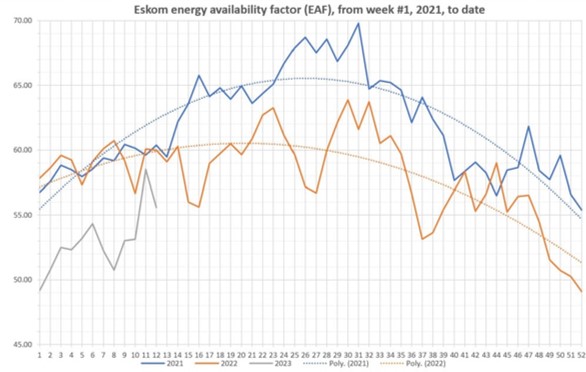
Yelland observed,
To increase Eskom’s EAF, there must first be a slowdown. It then has to bottom out, stabilise, and start to rise. This process will take several years… Talk of a 70% or 75% energy availability factor is misleading the public, and it is not achievable…
The IMF’s Article IV consultation noted that on average, Eskom received 1% of national GDP in transfers while incurring losses amounting to 0.4% of GDP in FY19/20 and FY20/21.
To rectify the situation, authorities resorted to a 15% tariff increase in 2022 as well as other cost control measures including headcount reduction.
This supported financial performance with operating profit surging 238% last year, but the company was unable to meet its debt service commitments despite a government injection of tens of billions of rand.
Through this period, service delivery has continued to remain unreliable.
The organization has not been without its share of major controversy following ongoing investigations into corruption as well as an explosive television interview by ex-CEO André de Ruyter earlier this year.
Yesterday, de Ruyter appeared before SCOPA, the committee on public accounts, refusing to provide names of ministers believed to be involved in the alleged wrongdoing.
Reports suggest that de Ruyter’s testimony only raised more questions further undermining trust in the energy supplier.
Policy initiatives
In late 2020, authorities attempted to improve the functioning of South Africa’s distressed public entities, many of which were plagued by ambiguous mandates and unsustainable business models, with the roll-out of the Economic Reconstruction and Recovery Plan (ERRP).
This included a host of energy-sector reforms including dividing Eskom into at least three entities with each being responsible for generation, transmission, or distribution.
In addition, the Office of the President and the National Treasury jointly launched Operation Vulindlela targeting high-impact structural reforms in many sectors including power generation and supply.
However, many of these reforms have faced difficulties in execution amid cost overruns, social unrest, and instances of large-scale vandalism.
Moreover, with the general elections scheduled for 2024, the unbundling of Eskom is likely to be a political hot potato, which would also require the passage of complicated legislative steps.
Platinum fundamentals
South Africa is a land of incredible natural resources.
A recent OECD Trade Policy Paper by Przemyslaw Kowalski and Clarisse Legendre highlighted the shares of the top 3 producing countries among the top 10 most concentrated critical raw materials.
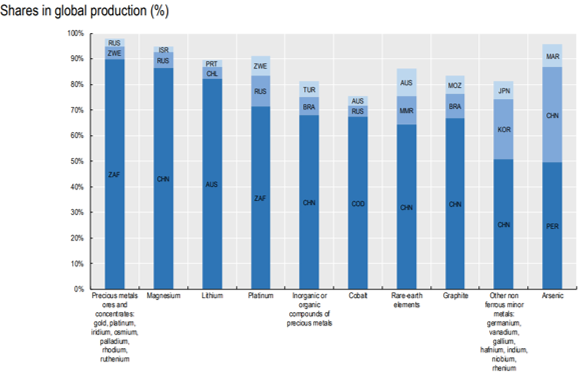
In the above graph, South Africa (ZAF) has a tight grip on the production of the precious metals group as well as on platinum (Pt) of which it is single-handedly responsible for over 70% of global output.
Interest in Pt has skyrocketed in recent years particularly due to increased automotive and jewellery demand in China, Japan, and India, as well as a range of expanding applications in medical care such as dental fillings and pacemakers.
Last year, prices of the metal had initially surged following Russia’s aggressive military actions and its position as the second-largest global supplier.
Price concerns were short-lived partly due to South Africa’s dominant position and China’s strict zero-covid policies.
Yet, the platinum spot price has seen a strong recovery improving 19.4% YoY at the time of writing, and trading 33% above the 52-week low of August.
Since the 27th of March, the spot has risen approximately 11%.
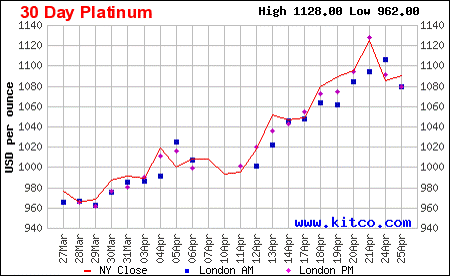
This shift higher has been driven by surging Chinese buying, which was well over expected demand, after exiting its prolonged lockdown policies.
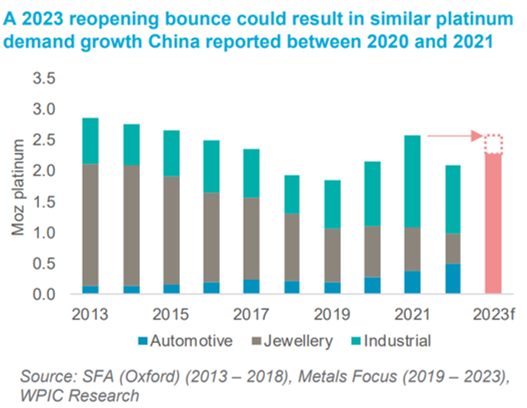
Improved economic data such as China’s general, manufacturing, and non-manufacturing PMI; and annual GDP growth; outperformed market expectations.
The China Association of Automobile Manufacturers (CAAM) estimates domestic vehicle sales to rise by 2.11 million units in 2023.
In particular, a recent ING report found that the share of electric vehicles in China’s total car registrations had begun to stagnate, suggesting that Pt demand may be spurred on by the use of catalytic converters in gasoline-run cars.
In addition, WPIC expects industrial demand such as from investments in the hydrogen economy and zero-carbon emitting power facilities to grow by 12% while investment demand should notch higher this year too.
However, South Africa, the centre of the global platinum mining sector remains riddled with operational inefficiencies and is on the threshold of a much more severe shutdown.
A Daily Maverick article from mid-March examined some of the challenges in South Africa’s broader mining industry.
The total output of the sector fell 7.2% in 2022, although this was in part due to the distorted base effect following the pandemic-era disruptions.
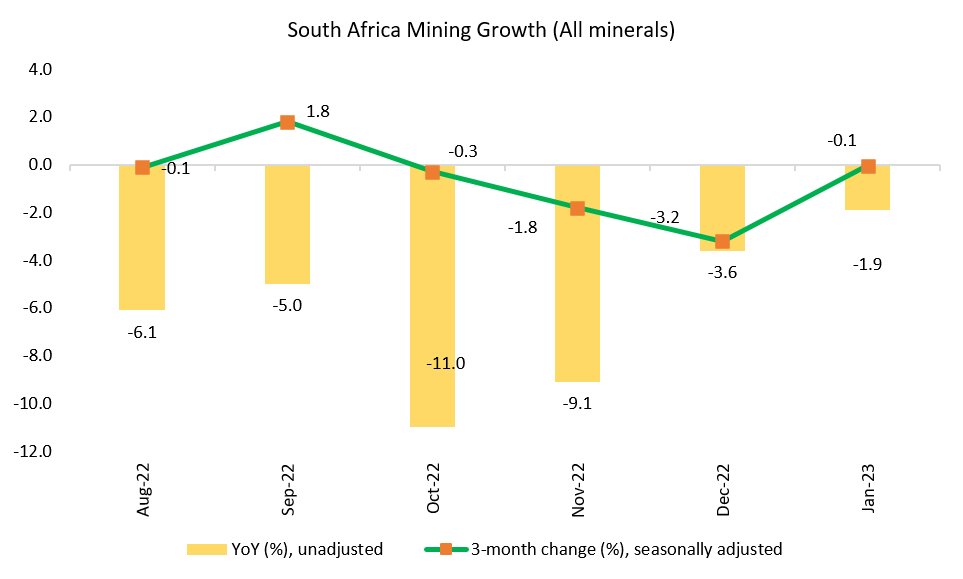
As a result of the deeply-entrenched power crisis, as well as an uptick in significant mine closures, the availability of lower mineral grades among ageing mines, and the lack of secure transportation, Canada’s Fraser Institute’s Annual Survey of Mining Companies placed South Africa in the bottom ten countries on the basis in its Investment Attractiveness Index as early as April of 2022.
Due to the tremendous pressure placed on the economy by the constant blackouts, Pt, which according to the Observatory of Economic Complexity was the country’s top export at $24.5 bn in 2021 could see a sharp decline in production.
Johan Theron, spokesperson for one of the largest miners, Impala Platinum Holders, noted that the power crisis was so acute that there may come a time,
…when you have certain days where we will stop sending people underground.
Surplus reversal
Given the global Pt revival coupled with alarming supply constraints, the WPIC projected demand growth for 2023 to increase by 24% while supply may improve by as little as 3% owing to limited additional capacity coming online.
Accordingly, the group expects that the prolonged power cuts will weigh heavily on South African operations, and may sharply reverse the industry surplus of 776 koz last year to a deficit of 556 koz this year.
Reports suggest that Eskom has advised major mining companies that they may need to cut back on production which will only exacerbate the situation.
Platinum ETFs
Given the metal’s demand-supply imbalance, the eroding reputation of the public utility, the precarious electricity supply situation and the fast-approaching winter season, fund managers expect Pt operations to be at significant risk, and are bullish on the prospects of platinum ETFs.
This turnaround comes shortly after these products witnessed several consecutive quarters of outflows on dampened global demand.
Bloomberg reports that weekly flows into platinum ETFs surged 117,000 ounces, the highest increase since March 2019 as investors rushed to these products en masse.
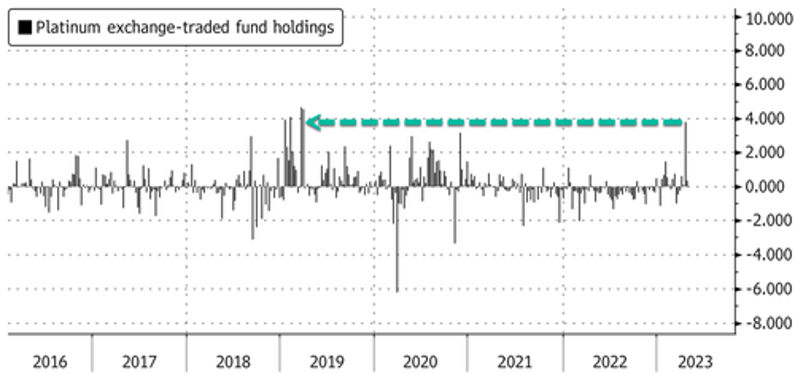
Several platinum ETFs such as the abrdn Physical Platinum Shares ETF (NYSEARCA: PPLT) and GraniteShares Platinum Trust (NYSEARCA: PLTM) are already up 12%-13% on the month.
A portion of the demand component may have been driven by concerns about persistent inflation, a weaker dollar and fears of a recession as the Fed looks to hike rates in the coming week.
Macroeconomic challenges
Pt supplies are likely to remain under heavy pressure for the foreseeable future and may see elevated prices through the oncoming winter season.
According to the Minerals Council of South Africa, the mining sector contributes 7-8% of South African GDP, and a sharp slowdown in this sector could have devastating macro-financial ramifications for export earnings, unemployment and growth.
The situation is even more desperate with several indications that the country is nearing a recession, and the IMF projecting that real GDP growth would slow to a crawl at 0.1% this year.
Lungile Mashele, an energy sector specialist estimated that since 2008, the long history of chronic power cuts in South Africa may have reduced the country’s potential GDP by a staggering 20% and could prove to be even more potent now.
In its Staff Concluding Statement from March, the Fund notes that it expects the public debt situation to continue to weaken for several years even if Eskom’s financial position improves.
The downside risks to platinum prices come from recent reports of renewed health concerns in China and tight monetary policy which could bring on a global recession in H2 2023.
ETF buyers will keenly watch the price action in the coming days as the markets may have been anticipating a much more forceful testimony by de Ruyter.
Other considerations
There has been a recent trend to substitute Pt into palladium operations due to the price divergence between the metals.
Interested readers can see an earlier Invezz report on the subject here.
However, with mining operations likely to be curtailed, Pt stakeholders are unlikely to make much more headway in a hurry.
Secondly, heavy sanctions on Russia as well as punitive taxation by the UK on platinum and palladium products earlier this year presented an opportunity to South Africa to further extend its dominance in these sectors.
With no obvious end to the electricity crisis, progress towards this goal will be challenging.
In the long run, Pt still has tremendous substitutive potential and robust demand drivers, which may create opportunities for other producers such as Zimbabwe and Canada.
The post Record platinum ETF inflows on Eskom’s woes and de Ruyter testimony appeared first on Invezz.
dollar
inflation
monetary
markets
policy
metals
mining
fed
monetary policy

Argentina Is One of the Most Regulated Countries in the World
In the coming days and weeks, we can expect further, far‐reaching reform proposals that will go through the Argentine congress.
Crypto, Crude, & Crap Stocks Rally As Yield Curve Steepens, Rate-Cut Hopes Soar
Crypto, Crude, & Crap Stocks Rally As Yield Curve Steepens, Rate-Cut Hopes Soar
A weird week of macro data – strong jobless claims but…
Fed Pivot: A Blend of Confidence and Folly
Fed Pivot: Charting a New Course in Economic Strategy Dec 22, 2023 Introduction In the dynamic world of economics, the Federal Reserve, the central bank…



















